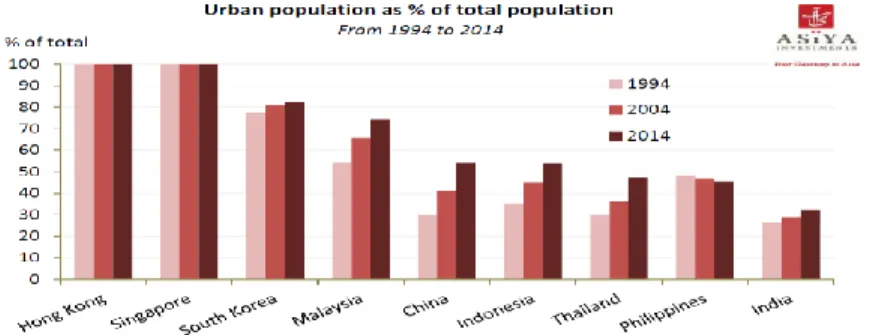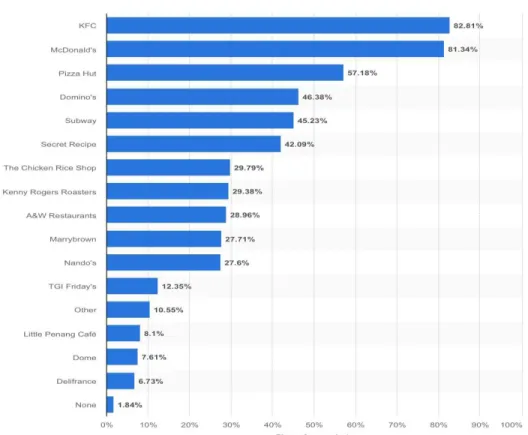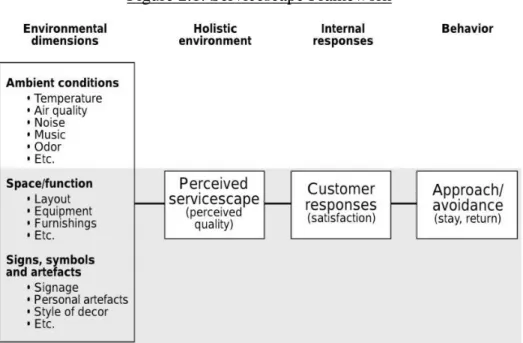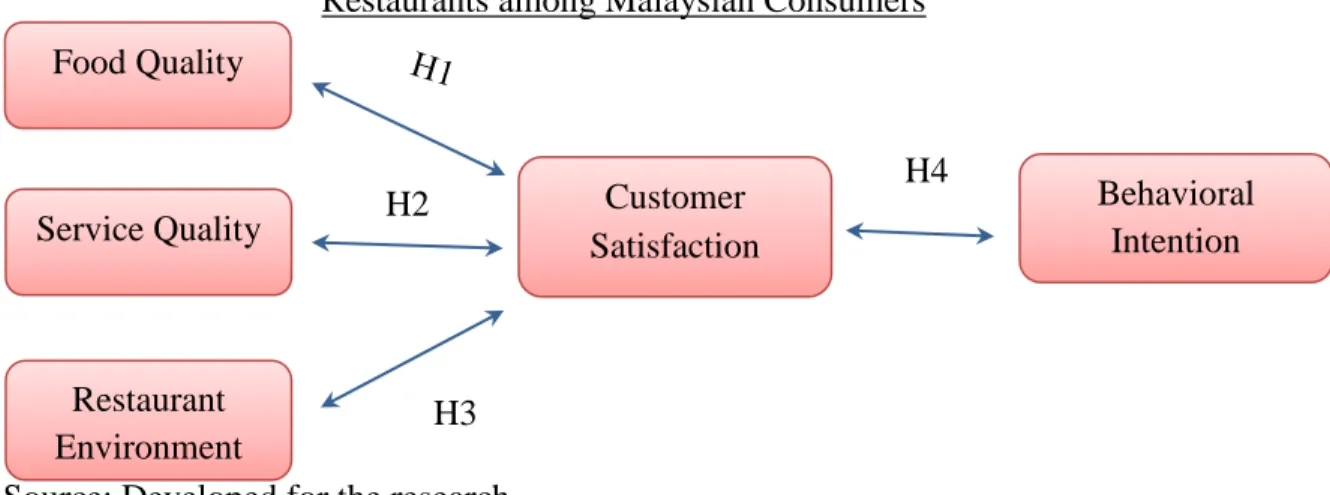INTRODUCTION
Research Background
- Background of Fast Food Industry
- Fast Food Industry in Malaysia
What's more, fast food concepts offer cuisine that fast food doesn't (or can't) and without the wait or price point of their casual dining contemporaries (Dombroski, 2015). Due to the increasing popularity of eating out, fast food restaurants have grown rapidly.
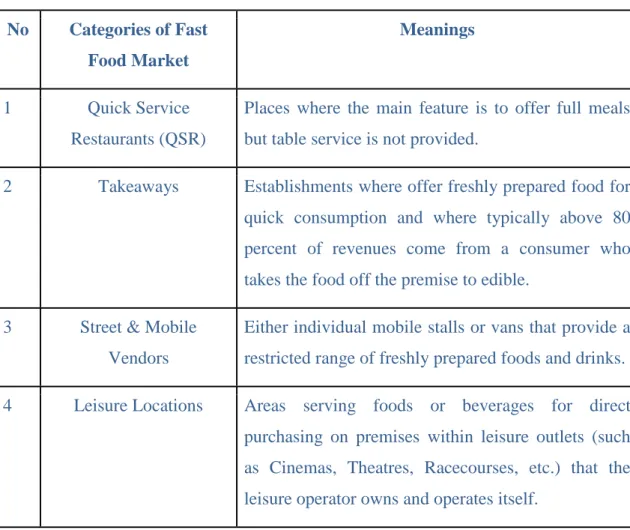
Problem Statement
However, it offers a higher quality and varied menu selection compared to fast food restaurants (Celentano, 2019). In addition, the author also stated that the atmosphere in fast food restaurants is also more prestigious than in fast food restaurants (Celentano, 2019).
Research Objectives
- General Objective
- Specific Objectives
Maximizing customer satisfaction by providing value to customers so that they return to visit the stores again, the satisfied customers can also recommend to potential customers and thus the likelihood of additional profit (Linton, 2019). To investigate the relationship between service quality and customer satisfaction. iii) To investigate the relationship between restaurant environment and customer satisfaction. iv).
Research Questions
Hypotheses of Study
Significance of Study
Therefore, it is important for American fast food marketers to foster a better understanding and knowledge of the elements that can stimulate Malaysian consumers' behavioral intention to revisit. By obtaining and understanding the elements that influence consumers' behavioral intention to review, marketers can design, develop and implement relevant marketing tactics to meet customer expectation.
Chapter Layout
Moreover, companies have the ability to build competitive advantages to compete with their competitors in the standardized sector after acquiring the useful data and knowledge to understand the target customers. Chapter four explains the result patterns and analyzes that are relevant to the questions and hypotheses of the research.
Conclusion
Thus, it has a main effect on customer satisfaction and behavioral intention to revisit the American fast food restaurant. There is a significant positive relationship between food quality, service quality, restaurant environment and customer satisfaction.
INTRODUCTION OF LITERATURE REVIEW
Literature Review
- Food Quality
- Restaurant Environment
- Customer Satisfaction
- Behavioral Intention
Taste is a communication that communicates with food to consumers that the quality of the food is based on the ingredients mixed in cooking (Shaharudin et al., 2011). Therefore, food quality is a major factor in attracting and satisfying the needs of customers in restaurants.
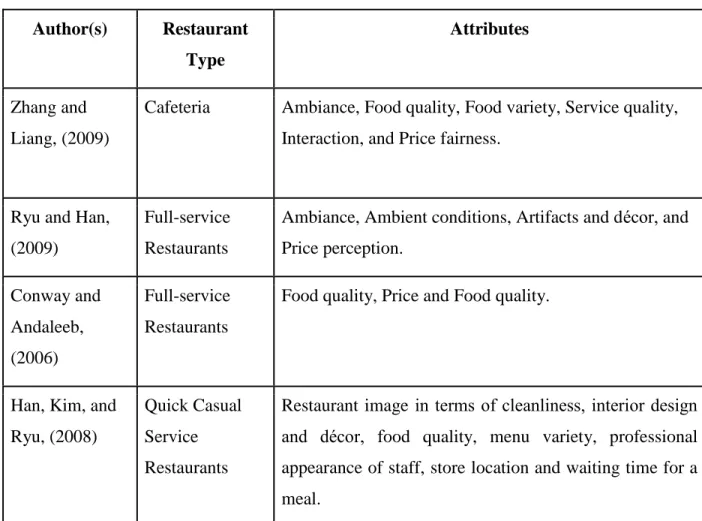
Review of Relevant Theoretical Models
The research framework shows "The role of food quality, service quality and physical environment on customer satisfaction and future behavioral intentions in a casual dining restaurant". This study uses four independent variables from this framework, which include food quality, service quality, restaurant environment, and customer satisfaction.
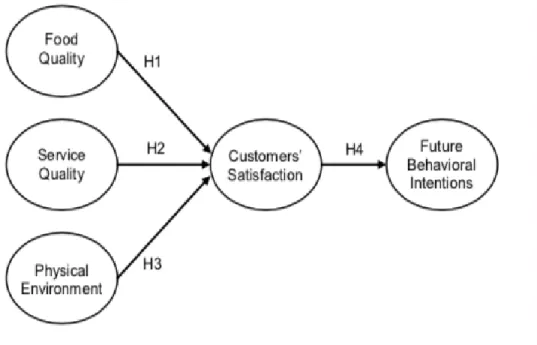
Conceptual Framework
Hypotheses Development
- The Relationship between Food Quality and Customer
- The Relationship between Service Quality and Customer
- The Relationship between Restaurant Environment and
- The Relationship between Customer Satisfaction and
In addition, it is general in fast food restaurant as customer satisfaction is determined by SERVPERF tool and originates from food quality, service quality and price ratio (Parasuraman et al., 1985). Many researchers also study the influence of environment on customer satisfaction and repurchase intention (Githiri, 2017; Ryu et al., 2010; Ryu et al., 2012). Many researchers also recommend that there is a significant positive relationship between customer satisfaction and the environment in the fast food industry (Massey & Raduzziet, 2018; Phan & Nguyen, 2016; Chang, 2000; Chebat & Michon, 2003).
In addition, Lee, Wang, and Cai (2015) also observed that the environment of a fast food restaurant is an indicator of customer satisfaction. Furthermore, Kim, Kim, & Goh (2011) also stated that customer satisfaction is an element that indicates whether a customer will have the intention to revisit a destination or repeat a purchase. Therefore, to expand or expand market segments in the food and beverage industry, customer satisfaction is a powerful predictor of customer intention to repurchase at the restaurant (Oh, 2000).
Conclusion
RESEARCH METHODOLOGY
- Research Design
- Descriptive Research
- Causal Research
- Data Collection Methods
- Primary Data
- Secondary Data
- Sampling Design
- Target Population
- Sampling Frame and Sampling Location
- Sampling Elements
- Sampling Technique
- Sampling Size
- Pilot Test
- Measurement Scales
- Data Processing
- Data Checking
- Data Editing
- Data Coding
- Data Transcribing
- Data Cleaning
- Data Analysis
- Conclusion
The author stated that primary data is the data that is collected for the first time by the researcher and is also factual data (Ajayi, 2017). From this research, the questionnaire method was chosen for data collection. These elements are important so that data generation can be performed more accurately in this study.
Other than that, it will also need to rearrange the order of the data and manipulate the data to produce descriptive information. Furthermore, convenience sampling which is used under non-probability sampling is used to select the 150 respondents who live in Klang Valley area so that the data will be more accurate. Therefore, the outcome of the statistical analysis will be discussed in chapter 4 according to the data collected.
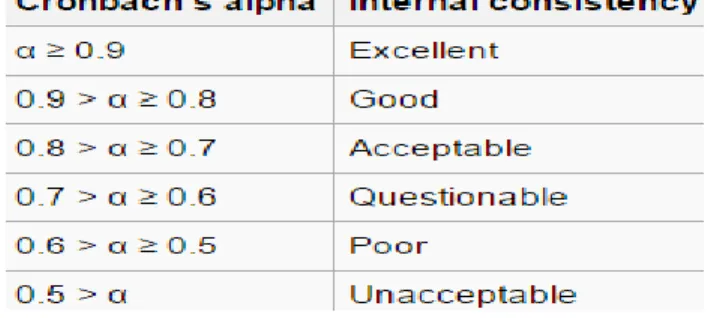
DATA ANALYSIS
Descriptive Analysis
- Respondent Demographic Profile
- Gender
- Age
- Occupation
- Monthly Income
- Respondent General Information
- Frequency of Visiting American Fast Food
- Preferred Meal Time
- Money Spent for a Meal in American Fast Food
- Reason that Choose to Dine In American Fast Food
- Descriptive Statistics
According to Table 4.5 and Figure 4.5, 50.8 percent or 61 respondents of the 120 respondents visit US fast food restaurants once a week, which is the highest percentage. According to Table 4.6 and Figure 4.6, a majority of the 65 interviewees prefer to visit American fast food restaurants during lunch. Based on Table 4.7 and Figure 4.7, there is a 0 percent or no respondent who usually spends less than RM5 for a meal in US fast food restaurants.
According to Table 4.8 and Figure 4.8, the analysis shows that 42.5 percent of respondents choose to dine at American fast food restaurants to save time. On the other hand, there are 22.5 percent or 27 respondents who decide to dine in American fast food restaurants because of the fun, and 21.7 percent because of the reasonable price. Finally, 13.3 percent of respondents dine in American fast food restaurants for special occasions.
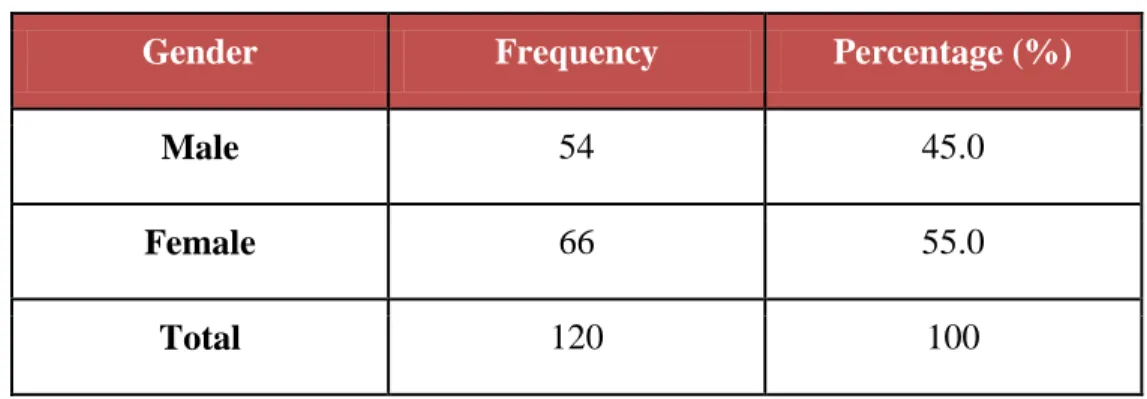
Scale Measurement
- Internal Reliability Test
- Hypotheses Testing
- Linear Regression Analysis
- Hypothesis Testing
It shows that the level of customer satisfaction will increase by 0.426 units if the quality of food increases by one unit, keeping the others constant. Therefore, food quality is a significant predictor of customer satisfaction, followed by restaurant environment (0.393) and service quality (0.172). Thus, H0 is rejected, which means that there is a significant positive relationship between food quality and customer satisfaction.
H0 is thus rejected, which means that there is a significant positive relationship between service quality and customer satisfaction. Thus, H0 is rejected, meaning that there is a significant positive relationship between restaurant environment and customer satisfaction. With respect to Table 4.16, the significant value of customer satisfaction is 0.000, which is lower than the p-value of 0.05.

Conclusion
DISCUSSION, CONCLUSION AND IMPLICATION
Summary of Statistical Analysis
- Descriptive Analysis
- Scale Measurement
- Reliability Analysis
- Inferential Analysis
- Multiple Regression Analysis
- Linear Regression Analysis
Among the five variables, customer satisfaction has the highest alpha coefficient of 0.942, followed by the behavioral intention construct, which is measured with 5 items and consists of 0.932. In Chapter 4, multiple regressions were conducted to examine the relationship between the independent variables of service quality, food quality and restaurant environment, and customer satisfaction and behavioral intention. In addition, 73.2 percent of the variation in customer satisfaction was accounted for by three independent variables, namely service quality, food quality, and restaurant environment.
Regarding Table 4.13, the results showed that all independent variables such as food quality, service quality, and restaurant environment have a strong influence on customer satisfaction. Among these three independent variables, food quality has the greatest impact on customer satisfaction, with a standardized beta of 0.395. According to the formulated equation, the regression coefficient of customer satisfaction is 0.902, and its standardized beta coefficient is 0.821.
Discussion of Major Findings
- Food Quality
- Service Quality
- Restaurant Environment
- Customer Satisfaction
The research objective of this study is achieved while exploring the relationship between food quality and customer satisfaction. It has thus proven that there is a significant positive relationship between the quality of service and customer satisfaction. The research objective of this study is achieved while exploring the relationship between service quality and customer satisfaction.
Therefore, it has been proven that there is a significant positive relationship between restaurant environment and customer satisfaction. The research objective of this study is achieved while examining the relationship between restaurant environment and customer satisfaction. The research objective of this study is achieved while examining the relationship between customer satisfaction and behavioral intention.
Implications of the Study
- Managerial Implications
- Food Quality
- Service Quality
- Restaurant Environment
- Customer Satisfaction
According to Kim et al. 2011) mentioned that customer satisfaction is a determining element in indicating whether a customer will have the intention to revisit a destination or repeat a purchase. Therefore, it has been determined that customer satisfaction has a significant positive and direct relationship with behavioral intention to revisit. Service quality has the most positive relationship to customer satisfaction and leads to behavioral intention to revisit.
There are many findings that reveal that the restaurant environment is another factor that affects the customer's dining experience on customer satisfaction and behavioral intention to revisit American fast food restaurants. Today, customer satisfaction is an important predictor of a company's future performance in order to predict customer retention (Cengiz, 2010). It shows that customer satisfaction has a significant positive relationship with behavioral intention to revisit.
Limitations of the Study
The customers are generally loyal to the restaurants and this will also increase the reputation of the restaurant. Furthermore, the sampling bias also occurred during the progress of the study. The frequency of the demographic profile of the respondents shows that there is an uneven distribution of respondents, with the majority of women being among the 120 respondents.
Otherwise, 88.3 percent of the respondents are in the age group of 18 to 30 years, and this accounted for more than half of the respondents. The majority of respondents are students compared to other professions, where students make up 70 percent of the total sample. In fact, some respondents may have misunderstood and misinterpreted the survey questionnaire, which will affect the attitude of the respondents when answering the survey questionnaire, they may simply or randomly choose the options provided as long as they can complete the questionnaire.
Recommendations for Future Research
The researchers should draft the questionnaire with Malay and Mandarin so that the respondents have better understanding, as most interviewees tend to be native speakers and have different educational backgrounds. Thus, it can not only collect the accurate and reliable response from different respondents and can also reduce the requirement for the researchers to further explain the meaning of the questions. Finally, the researchers can learn some technical skills to access the journal articles for free through participating workshops.
Therefore, the researchers can save more budgets for the purchase of the journal articles and easily generate more journal articles to support the research. The researchers can visit the public library to find more journal articles if the time allows. Thus, researchers may be able to find the journal articles in one place rather than spending more time searching the journal articles using search engines.
Conclusion
An Analysis of Factors Affecting Customer Satisfaction in Vietnam Restaurants: Case of Fast Food Restaurants. Retrieved March 24, 2019, from https://www.second-to-none.com/from-fast-food-to-fast-casual-part-one/. The topic of our research project is "Behavioral into American Fast Food Restaurants Among Malaysian Consumers".
Why do you choose to eat in American Fast Food restaurants rather than other traditional restaurants. American fast food restaurants are willing to help each other maintain speed and quality of service. 3 The food served by the American fast food restaurants is exactly the same as illustrated.
2 I am satisfied with the American fast food restaurants and it puts me in a good mood. 5 I would consider the American fast food restaurants as one of my options on the menu.

